The global soy-based food market is projected to grow from USD 17.8 billion in 2025 to USD 32.1 billion by 2035, registering a CAGR of 6.1%.
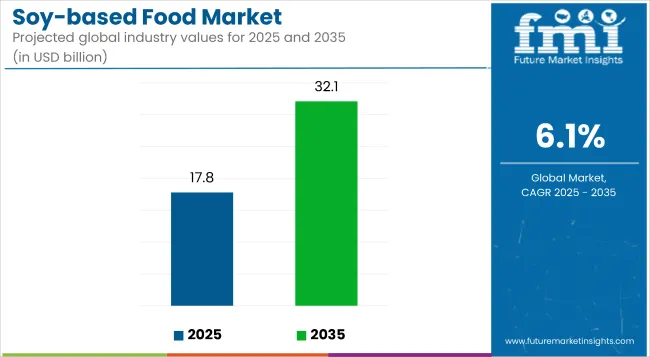
| Metric | Value |
|---|---|
| Industry Size (2025E) | USD 17.8 billion |
| Industry Value (2035F) | USD 32.1 billion |
| CAGR (2025 to 2035) | 6.1% |
The market expansion is driven by rising demand for plant-based proteins, health-conscious diets, and innovations in soy product applications across meat substitutes, dairy alternatives, and functional foods. Manufacturers are expand their portfoliosto meet the needs of vegan, vegetarian, and flexitarian consumers, driving overall market growth.
The market holds an estimated 100% share of the soy protein market, reflecting its core role in this segment. Within the plant-based protein market, it commands 28%, emphasizing its importance in protein-rich meat and dairy alternative applications.
It contributes around 12% to the overall functional food market and nearly 8% to the global health and wellness food market. However, in the expansive global food and beverage market, its share remains below 0.3%.
Government regulations impacting the market focus on food safety, sustainability, and consumer health. Standards such as the FDA’s GRAS approval in the United States, European Food Safety Authority (EFSA) regulations in the UK, Germany, and France, and Japan’s Food Sanitation Act ensure quality control and compliance. Non-GMO labelling standards and organic certifications further drive investment in sustainable sourcing and production transparency.
UK is projected to be the fastest-growing market, expected to expand at a CAGR of 6.5% from 2025 to 2035. Meat substitute will lead the product type segment with a 35.2% share, while offline will dominate the distribution channel segment with a 47.6% share. The USA and Germany markets are also expected to grow steadily at CAGRs of 6.3% and 6.2%, respectively.
The market is segmented by product type, application, distribution channel, and region. By product type, the market is divided into meat substitute, non-dairy yogurt, non-dairy spread, non-dairy ice cream, and non-dairy cheese.
Based on application, the market is classified into meat products, dairy products, bakery &confectionery, functional food, and instant food. By distribution channel, the market is segmented into direct/B2B, offline, and online. Regionally, the market is classified into North America, Latin America, Europe, South Asia, East Asia, Oceania, and Middle East & Africa.
Meat substitute isprojected to lead the product type segment, capturing 35.2% of the market share by 2025. These products replicate the taste and texture of traditional meat, appealing to vegetarian and flexitarian consumers.
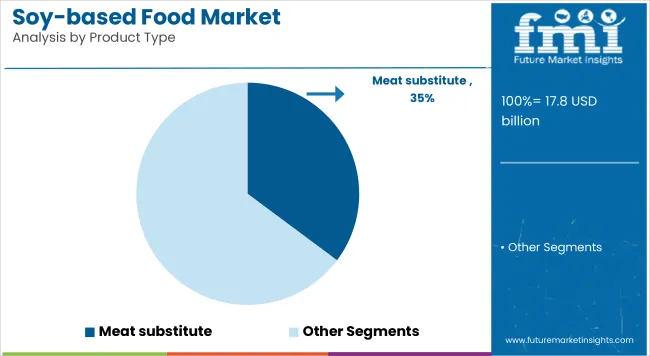
Dairy products are expected to dominate the application segment, capturing 28% of the global market share by 2025. This leadership is driven by increasing consumer preference for plant-based dairy alternatives that align with health-conscious, vegan, and lactose-intolerant dietary needs.
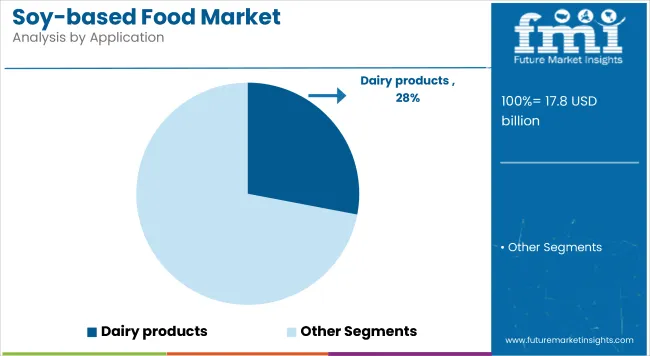
Offline is projected to dominate the distribution channel segment, accounting for 47.6% of the global market share by 2025. This is attributed to the strong presence of supermarkets, hypermarkets, and health food stores offering consumers direct access to products, enabling evaluation of freshness, packaging, and labels before purchase.
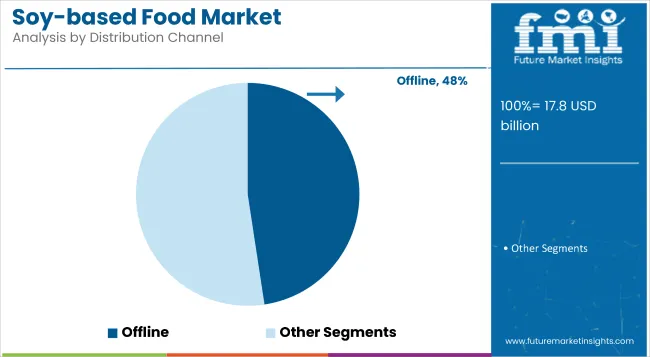
The global soy-based food market is experiencing steady growth, driven by the rising demand for plant-based protein alternatives and health-conscious dietary shifts across regions. Soy-based foods play a crucial role in providing sustainable, high-protein options for vegan, vegetarian, and flexitarian consumers, supporting market expansion through diverse product innovations and applications in meat substitutes and dairy alternatives.
Recent Trends in the Soy-based Food Market
Challenges in the Soy-based Food Market
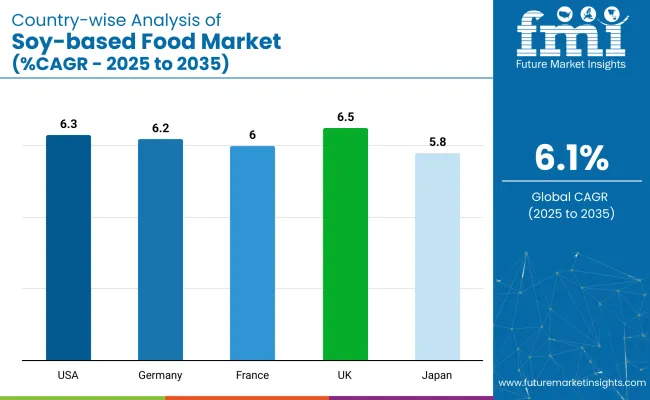
The UK leads with the highest CAGR at 6.5%, driven by strong vegan and flexitarian trends. The USA follows at 6.3%, fueled by millennials and Gen Z adopting plant-based diets. Germany records a 6.2% CAGR, supported by clean label and wellness trends. France shows a 6% CAGR, with rising soy dairy substitutes and snacks.
Japan has the lowest growth at 5.8%, despite strong traditional soy consumption and plant-based meat demand. Overall, Western markets lead growth driven by health, sustainability, and dietary shifts, while Japan grows steadily with a focus on fortified, premium soy products.
The report covers in-depth analysis of 40+ countries; five top-performing OECD countries are highlighted below.
The Japan soy-based food revenue is growing at a CAGR of 5.8% from 2025 to 2035. Growth is driven by traditional consumption of tofu, soy milk, and fermented products combined with rising demand for plant-based meats. Japan prioritizes high-quality, fortified soy products that align with health and sustainability goals.
The sales of soy-based food in the USA are expected to expandat 6.3% CAGR during the forecast period, slightly above the global average. Key drivers include growing plant-based diets among Millennials and Gen Z, coupled with demand for high-protein and low-fat products.
The Germany soy-based food market is projected to grow at a 6.2% CAGR during the forecast period. Strong health and wellness trends, coupled with demand for meat and dairy alternatives, support market expansion.
The Frenchsoy-based food market is expected to grow at a CAGR of 6% from 2025 to 2035. Consumer interest in healthful eating, coupled with demand for plant-based alternatives, drives sales.
The UK soy-based food revenueis projected to grow at a CAGR of 6.5% from 2025 to 2035. Plant-based diets continue to rise, with soy-based meat substitutes and dairy alternatives gaining market share.
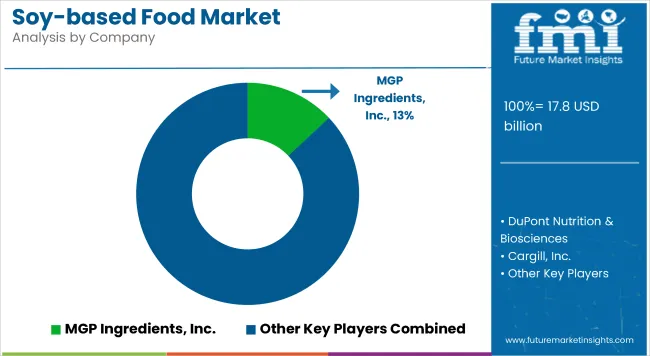
The market is moderately consolidated, with leading players like MGP Ingredients, Inc., DuPont Nutrition & Biosciences, Cargill, Inc., Archer Daniels Midland Company (ADM), and Bunge Limited dominating the industry. These companies provide a wide range of soy-based ingredients and finished products catering to industries such as food and beverages, nutraceuticals, and functional foods. MGP Ingredients, Inc. focuses on high-quality soy protein isolates and concentrates, while DuPont Nutrition & Biosciences supplies advanced soy-based emulsifiers, proteins, and fortification solutions for various applications.
Cargill, Inc. delivers sustainable, non-GMO soy ingredients with strong global sourcing capabilities. Archer Daniels Midland Company (ADM) offers innovative soy protein isolates and textured vegetable proteins used in meat substitutes and dairy alternatives. Bunge Limited integrates soybean processing with food manufacturing solutions to deliver versatile soy products for different consumer needs.
Recent Soy-based Food Industry News
| Report Attributes | Details |
|---|---|
| Market Size (2025) | USD 17.8 billion |
| Projected Market Size (2035) | USD 32.1 billion |
| CAGR (2025 to 2035) | 6.1% |
| Base Year for Estimation | 2024 |
| Historical Period | 2020 to 2024 |
| Projections Period | 2025 to 2035 |
| Report Parameter | USD billion for value/volume in million tons |
| Product Type Analyzed | Meat Substitute, Non-dairy Yogurt, Non-dairy Spread, Non-dairy Ice Cream, and Non-dairy Cheese |
| Application Analyzed | Meat Products, Dairy Products, Bakery and Confectionery, Functional Food, and Instant Food |
| Distribution Channel Analyzed | Direct/B2B, Offline, and Online |
| Regions Covered | North America, Latin America, Europe, East Asia, South Asia, Oceania, and Middle East and Africa |
| Countries Covered | United States, United Kingdom, Germany, France, Japan, China, India, Brazil, South Korea, Australia |
| Key Players Influencing the Market | MGP Ingredients, Inc., DuPont Nutrition & Biosciences, Cargill, Inc., Archer Daniels Midland Company (ADM), Bunge Limited, The Hain Celestial Group, Nutraceutical Corporation, Sunrich Foods, and Pinnacle Foods |
| Additional Attributes | Dollar sales by source type, purity analysis, regional demand growth, regulatory influence, competitive benchmarking |
According to the Product Type, the industry has been categorized into Meat Substitute (Textured Vegetable Protein, Tofu, and Tempeh), Non- dairy Yogurt, Non-dairy Spread, Non- dairy Ice Cream, and Non- dairy Cheese.
As per Application, the industry has been categorized into Meat Products, Dairy Products, Bakery & Confectionery, Functional Food, and Instant Food.
As per the Distribution Channel, the industry has been categorized into Direct/B2B, Offline (Hypermarket/Supermarket, Convenience Stores, Specialty Stores, Pharmacy & Drug Store, Health & Wellness Store, and Other Offline based Stores), and Online (Company Website, E-commerce Platform, and Hyperlocal Delivery).
Industry analysis has been carried out in key countries of North America, Latin America, Europe, East Asia, South Asia, Oceania, and the Middle East & Africa.
The market is valued at USD 17.8 billion in 2025.
The market is forecasted to reach USD 32.1 billion by 2035, reflecting a CAGR of 6.1%.
Meat substitute will lead the product type segment, accounting for 35.2% of the global market share in 2025.
Offline will dominate the distribution channel segment with a 47.6% share in 2025.
The UK is projected to grow at the fastest rate, with a CAGR of 6.5% from 2025 to 2035.






Our Research Products

The "Full Research Suite" delivers actionable market intel, deep dives on markets or technologies, so clients act faster, cut risk, and unlock growth.

The Leaderboard benchmarks and ranks top vendors, classifying them as Established Leaders, Leading Challengers, or Disruptors & Challengers.

Locates where complements amplify value and substitutes erode it, forecasting net impact by horizon

We deliver granular, decision-grade intel: market sizing, 5-year forecasts, pricing, adoption, usage, revenue, and operational KPIs—plus competitor tracking, regulation, and value chains—across 60 countries broadly.

Spot the shifts before they hit your P&L. We track inflection points, adoption curves, pricing moves, and ecosystem plays to show where demand is heading, why it is changing, and what to do next across high-growth markets and disruptive tech

Real-time reads of user behavior. We track shifting priorities, perceptions of today’s and next-gen services, and provider experience, then pace how fast tech moves from trial to adoption, blending buyer, consumer, and channel inputs with social signals (#WhySwitch, #UX).

Partner with our analyst team to build a custom report designed around your business priorities. From analysing market trends to assessing competitors or crafting bespoke datasets, we tailor insights to your needs.
Supplier Intelligence
Discovery & Profiling
Capacity & Footprint
Performance & Risk
Compliance & Governance
Commercial Readiness
Who Supplies Whom
Scorecards & Shortlists
Playbooks & Docs
Category Intelligence
Definition & Scope
Demand & Use Cases
Cost Drivers
Market Structure
Supply Chain Map
Trade & Policy
Operating Norms
Deliverables
Buyer Intelligence
Account Basics
Spend & Scope
Procurement Model
Vendor Requirements
Terms & Policies
Entry Strategy
Pain Points & Triggers
Outputs
Pricing Analysis
Benchmarks
Trends
Should-Cost
Indexation
Landed Cost
Commercial Terms
Deliverables
Brand Analysis
Positioning & Value Prop
Share & Presence
Customer Evidence
Go-to-Market
Digital & Reputation
Compliance & Trust
KPIs & Gaps
Outputs
Full Research Suite comprises of:
Market outlook & trends analysis
Interviews & case studies
Strategic recommendations
Vendor profiles & capabilities analysis
5-year forecasts
8 regions and 60+ country-level data splits
Market segment data splits
12 months of continuous data updates
DELIVERED AS:
PDF EXCEL ONLINE
Food & Beverage OEE Software Market Size and Share Forecast Outlook 2025 to 2035
Food Grade Crosslinked Polyvinylpolypyrrolidone (PVPP) Market Size and Share Forecast Outlook 2025 to 2035
Food Grade Cassia Gum Powder Market Size and Share Forecast Outlook 2025 to 2035
Food Grade Dry Film Lubricant Market Size and Share Forecast Outlook 2025 to 2035
Foodservice Equipment Market Analysis - Size, Share, and Forecast Outlook 2025 to 2035
Food Basket Market Forecast and Outlook 2025 to 2035
Food Grade Tremella Polysaccharide Market Size and Share Forecast Outlook 2025 to 2035
Food Sorting Machine Market Size and Share Forecast Outlook 2025 to 2035
Foodservice Paper Bag Market Size and Share Forecast Outlook 2025 to 2035
Food Stabilizers Market Size and Share Forecast Outlook 2025 to 2035
Food Packaging Film Market Size and Share Forecast Outlook 2025 to 2035
Food Certification Market Size and Share Forecast Outlook 2025 to 2035
Food Tray Market Size and Share Forecast Outlook 2025 to 2035
Food & Beverage Industrial Disinfection and Cleaning Market Size and Share Forecast Outlook 2025 to 2035
Food Technology Market Size and Share Forecast Outlook 2025 to 2035
Food Tourism Sector Market Size and Share Forecast Outlook 2025 to 2035
Food Processing Boiler Market Size and Share Forecast Outlook 2025 to 2035
Food Packaging Machines Market Size and Share Forecast Outlook 2025 to 2035
Food Minerals Market Size and Share Forecast Outlook 2025 to 2035
Food And Beverage Chemicals Market Size and Share Forecast Outlook 2025 to 2035

Thank you!
You will receive an email from our Business Development Manager. Please be sure to check your SPAM/JUNK folder too.
Chat With
MaRIA